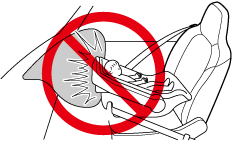

Baby Seat Installation Position
A baby seat is used in the rear-facing position only.
Refer to the table, "Child-Restraint System Suitability for Various Seat Positions" for baby seat installation position (Search).
Always install a baby seat in the correct seat position:
Installing a baby seat without first consulting the table “Child-Restraint System Suitability for Various Seat Positions” is dangerous. A baby seat installed on the wrong seat position cannot be properly secured. In a collision, the child could hit something or someone in the vehicle and be seriously injured or even killed.
Never use a rear-facing child-restraint system on the passenger seat protected by an air bag:
Extreme Hazard! Do not use a rearward facing child restraint on a seat protected by an airbag in front of it!
The child-restraint system can be hit by the deploying air bag and knocked out of position. A child in the child-restraint system could be seriously injured or killed. If your vehicle is equipped with a passenger occupant, always make sure the passenger air bag deactivation OFF indicator light is illuminated, if installing a rear-facing child-restraint system on the passenger seat is unavoidable.





